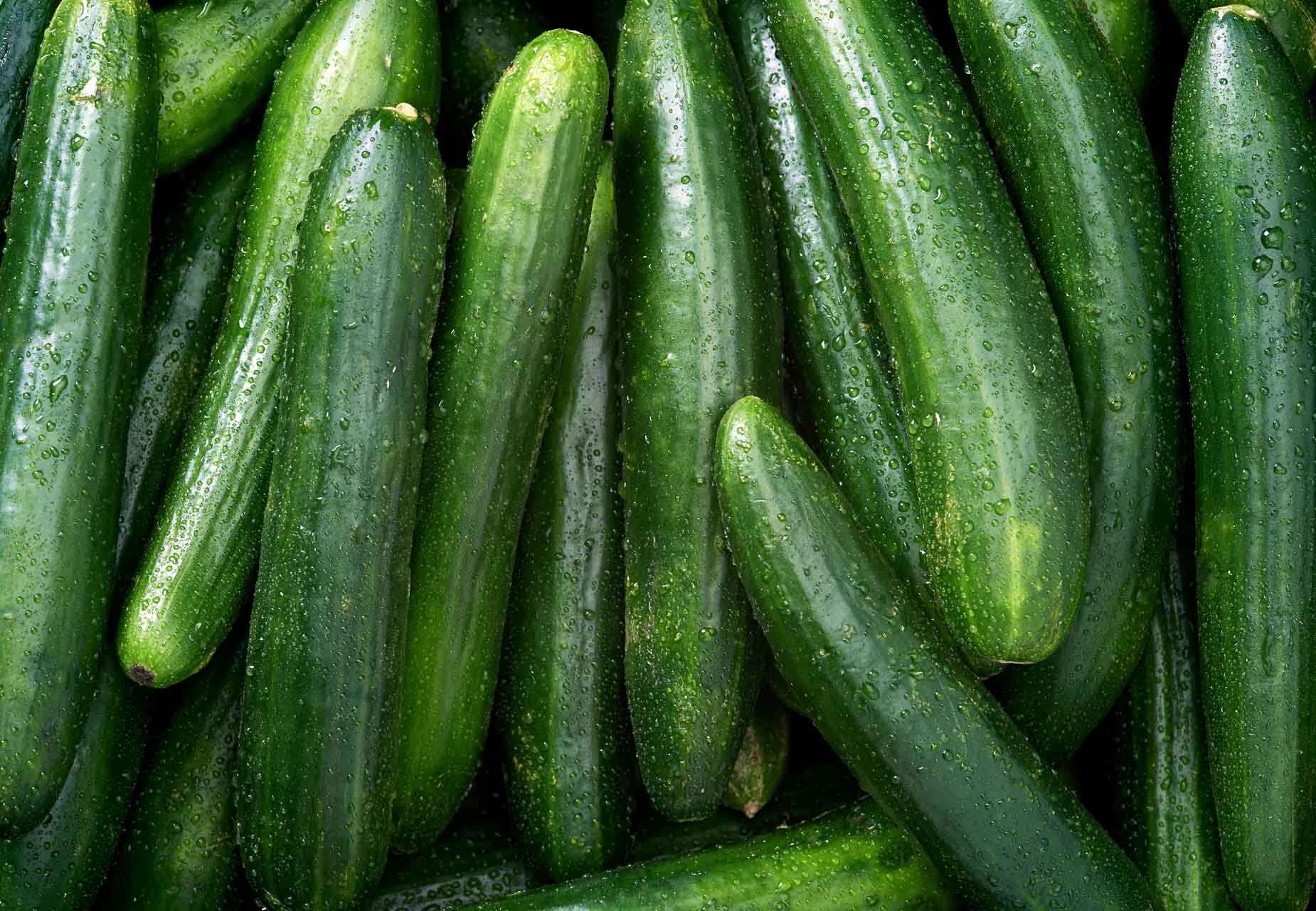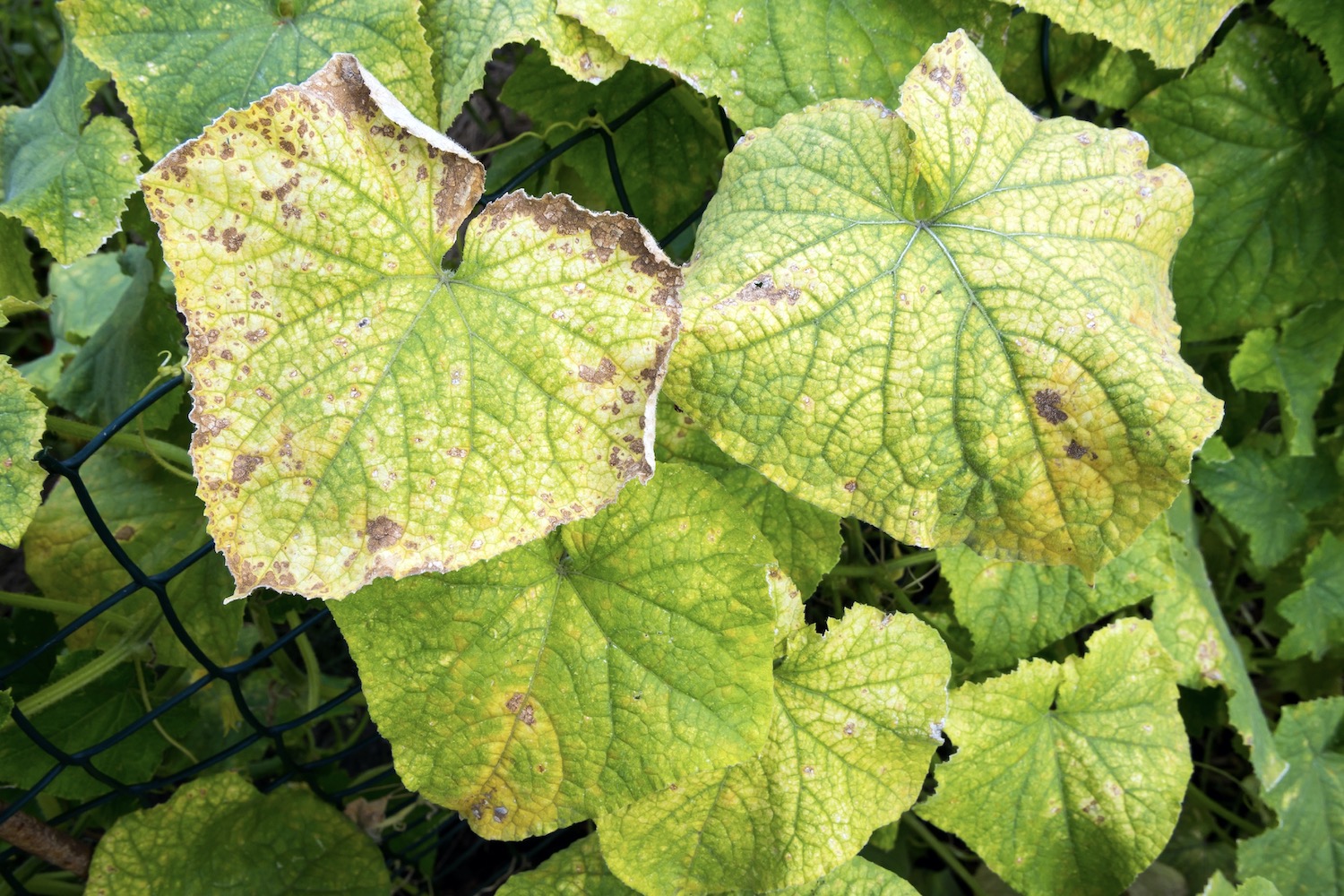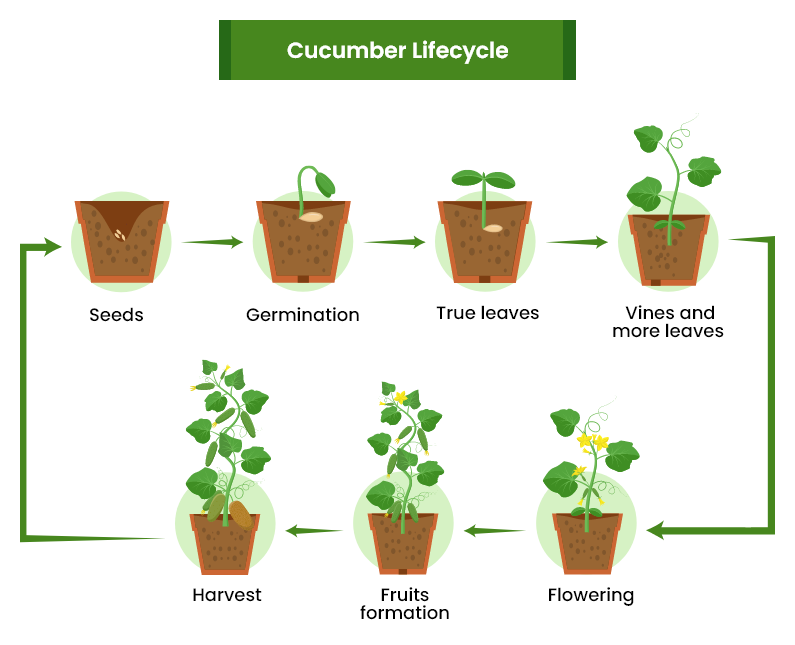Introduction to Cucumbers
Cucumbers (Cucumis sativus) are popular garden vegetables known for their refreshing taste and versatility in the kitchen. These warm-season crops belong to the Cucurbitaceae family, which includes melons, squash, and pumpkins.
With proper care, cucumber plants can produce an abundance of fruit throughout the growing season. This guide will walk you through everything you need to know to successfully grow cucumbers in your garden.
Warm Season Crop
Thrives in temperatures between 65-85°F (18-29°C)
Full Sun
Requires 6-8 hours of direct sunlight daily
Regular Water
Needs consistent moisture for best results
Popular Cucumber Varieties
Cucumbers come in many varieties, each with its own unique characteristics. They’re broadly classified into three main types:
Slicing Cucumbers

Developed for fresh eating, slicing cucumbers typically grow 6-9 inches long with a smooth, dark green skin. These varieties have been bred to have a mild flavor and tender skin.
Popular Varieties:
- Straight Eight
- Marketmore
- Salad Bush
Pickling Cucumbers

Shorter and stouter than slicing cucumbers, pickling varieties have thicker skins and bumpy surfaces that hold pickling spices well. They’re typically harvested at 3-5 inches long.
Popular Varieties:
- National Pickling
- Homemade Pickles
- Boston Pickling
Burpless/English
:max_bytes(150000):strip_icc()/Seedless-Cucumber-57a0a3265f9b589aa9aabfcc.jpg)
These cucumbers are longer (often 10-12 inches), have thinner skins, fewer seeds, and milder flavor. They’re named “burpless” because they contain less cucurbitacin, the compound that can cause digestive discomfort.
Popular Varieties:
- English Telegraph
- Sweet Success
- Tasty Green
Specialty Cucumber Types
Persian Cucumbers
Shorter, thinner-skinned variety with sweet flavor and crunchy texture
Armenian Cucumbers
Actually a melon; long, ribbed fruit with light green skin
Lemon Cucumbers
Small, round yellowish cucumbers with mild flavor
Site Selection & Soil Preparation
Perfect Location
-
Full Sun
Cucumbers need at least 6-8 hours of direct sunlight daily. Choose the sunniest spot in your garden.
-
Protection from Strong Winds
Cucumber vines and leaves are delicate. If your garden is windy, consider providing a windbreak or choose a sheltered location.
-
Access to Water
Select a location with easy access to water. Cucumbers need consistent moisture, especially during flowering and fruiting.
Ideal Soil Conditions
-
Warm Soil
Soil temperature should be at least 65°F (18°C) for seed germination. Plant after all danger of frost has passed.
-
pH Level
Cucumbers prefer slightly acidic to neutral soil with a pH between 6.0 and 7.0. Test your soil and adjust if necessary.
-
Well-Draining
Ensure soil drains well while still retaining enough moisture. Add organic matter to improve drainage in heavy soils.
Soil Preparation Steps
Remove Debris
Clear the planting area of rocks, sticks, and weeds. Cultivate to loosen the soil 8-12 inches deep.
Add Organic Matter
Mix in 2-3 inches of compost or well-rotted manure to improve fertility and soil structure.
Pre-Fertilize
Incorporate a balanced fertilizer (like 10-10-10) according to package directions before planting.
Planting Cucumbers
When to Plant
-
Timing: Plant cucumbers after all danger of frost has passed and soil temperatures reach at least 65°F (18°C).
-
Indoor Start: For an earlier harvest, start seeds indoors 3-4 weeks before last frost date.
-
Succession Planting: Plant seeds every 2-3 weeks until midsummer for continuous harvests.
Growing Methods
In-Ground
Traditional method where cucumbers spread across garden space. Requires more room but less maintenance.
Raised Beds
Provides better drainage and soil warming. Ideal for small gardens or areas with poor soil.
Containers
Good for small spaces or patios. Choose bush varieties or provide vertical support for vining types.
Vertical Growing
Saves space, increases air circulation, and makes harvesting easier. Requires trellises or supports.
Planting Steps
Prepare Planting Area
Create mounds or hills 1-2 feet in diameter and 6-8 inches tall for better drainage.
Direct Seeding
Plant seeds 1 inch deep, 2-3 seeds per location. Space hills 3-5 feet apart for vining varieties, or plant seeds 8-12 inches apart in rows.
Transplanting Seedlings
If starting indoors, transplant when seedlings have 2-3 true leaves. Be careful not to disturb roots during transplanting.
Thinning
Once seedlings emerge with their first true leaves, thin to the strongest 1-2 plants per hill or every 12 inches in rows.
Initial Watering
Water thoroughly after planting to settle soil around seeds or roots.

Cucumbers growing vertically on a trellis system – saving space and improving airflow
Growing & Caring for Cucumbers
Watering
Consistent moisture is crucial for cucumbers. Irregular watering can lead to bitter fruit and reduced yields.
-
Amount: Provide 1-2 inches of water per week, either from rainfall or irrigation.
-
Timing: Water in the morning to allow foliage to dry before evening, reducing disease risk.
-
Method: Water at the base of plants to keep leaves dry. Soaker hoses or drip irrigation are ideal.
Fertilizing
Cucumbers are heavy feeders that benefit from regular fertilization throughout the growing season.
-
Initial: Mix compost and balanced fertilizer into soil before planting.
-
Schedule: Apply a balanced fertilizer or compost tea every 3-4 weeks during growing season.
-
Warning: Avoid high-nitrogen fertilizers once fruiting begins as they promote leaf growth at expense of fruit.
Mulching
Mulch helps maintain soil moisture, suppress weeds, and keep fruits clean.
-
Materials: Straw, shredded leaves, or clean grass clippings work well.
-
Depth: Apply 2-3 inches of organic mulch around plants after they’re established.
-
Benefit: Plastic mulch can help warm soil for early planting and deter pests.
Support Systems
Supporting cucumber vines improves air circulation, increases yield, and makes harvesting easier.
A-Frame Trellis
Sturdy, easy to build, and allows access from both sides. Great for garden rows.
Fence or Netting
Simple and effective. Secure netting to posts or use existing garden fencing.
Teepee Support
Space-saving option that works well for container growing.
Cage Support
Tomato cages work well for bush cucumber varieties in containers.

Cucumbers growing vertically on a trellis system
Maintenance Tasks
Pruning
- Remove yellowing or diseased leaves promptly
- For vining varieties, pinch off the growing tips when vines reach desired length
- Thin excessive side shoots to improve air circulation
Training Vines
- Gently guide young vines up supports
- Use soft plant ties or strips of cloth to secure vines
- Check weekly and adjust ties as plants grow
Monitoring
- Check plants daily once they start producing
- Look for signs of pests or diseases on leaves and fruit
- Harvest fruits promptly to encourage continued production
Pollination
- Encourage pollinators by planting flowers nearby
- If growing in greenhouse, hand pollinate by transferring pollen with a small brush
- Most modern varieties are self-pollinating
Common Problems & Solutions
Common Pests
Cucumber Beetles
Yellow and black spotted or striped beetles that feed on leaves, stems, and flowers. They also spread bacterial wilt disease.
Solution:
- Use floating row covers until flowering
- Plant companion plants like nasturtium and radishes
- Remove beetles by hand or use insecticidal soap
Aphids
Small soft-bodied insects that cluster on leaves and stems, sucking plant juices and causing leaves to curl.
Solution:
- Spray plants with strong water jet to dislodge aphids
- Introduce beneficial insects like ladybugs
- Apply insecticidal soap or neem oil
Spider Mites
Tiny spider-like pests that cause stippling on leaves. Severe infestations create fine webbing on plants.
Solution:
- Increase humidity around plants
- Spray plants with water to remove mites
- Apply insecticidal soap or horticultural oil

Common cucumber pest damage
Common Diseases
Powdery Mildew
White powdery growth on leaves and stems. Leaves may yellow and die prematurely. Common in humid conditions.
Solution:
- Space plants adequately for good air circulation
- Water at base of plants, keep foliage dry
- Apply fungicide or baking soda solution
- Choose resistant varieties
Bacterial Wilt
Plants suddenly wilt despite adequate soil moisture. Stems may ooze milky sap when cut. Spread by cucumber beetles.
Solution:
- Remove and destroy infected plants immediately
- Control cucumber beetles to prevent spread
- Practice crop rotation (don’t plant cucurbits in same spot for 2 years)
- Choose resistant varieties
Angular Leaf Spot
Water-soaked spots on leaves that become angular and yellow, eventually turning brown and dropping out.
Solution:
- Use pathogen-free seeds
- Rotate crops
- Water at base of plants
- Apply copper-based fungicides

Common cucumber disease symptoms
Other Growing Challenges
Bitter Cucumbers
Caused by stress, inconsistent watering, or high temperatures.
- Maintain consistent watering schedule
- Mulch to maintain soil moisture
- Harvest cucumbers when young
- Choose bitter-free varieties
Poor Fruit Set
Can be caused by extreme temperatures, lack of pollinators, or improper fertilization.
- Plant flowers to attract pollinators
- Hand pollinate if necessary
- Avoid excessive nitrogen fertilizers
- Maintain temperatures between 65-85°F (18-29°C)
Misshapen Fruits
Often results from poor pollination or environmental stress.
- Ensure adequate pollination
- Maintain consistent growing conditions
- Avoid overfertilizing with nitrogen
Yellowing Leaves
Can indicate nutrient deficiencies, overwatering, or disease.
- Ensure proper drainage
- Apply balanced fertilizer
- Check for pests on underside of leaves
- Remove severely affected leaves
Harvesting & Storage
When to Harvest

Harvest timing depends on the variety and intended use. Regular harvesting encourages continued production.
-
Slicing Varieties
Harvest when 6-8 inches long and dark green. The skin should be firm but not hard.
-
Pickling Varieties
Pick when 2-4 inches long for best texture and flavor.
-
English/Burpless Varieties
Harvest when 10-12 inches long but still slender.
Harvesting Tips
- Harvest frequently (every 1-2 days) when plants are producing
- Use garden shears or sharp knife to cut cucumbers from vine
- Leave a small piece of stem (1/2 inch) attached to the fruit
- Morning is the best time to harvest when fruits are cool and crisp
- Don’t leave overripe cucumbers on the vine as they’ll signal the plant to stop producing
Storage & Preservation
Short-Term Storage
- Store unwashed cucumbers in the refrigerator
- Wrap in a paper towel or place in a perforated plastic bag
- Keep in the vegetable crisper drawer
- Best used within 1 week for optimal flavor and texture
- Avoid storing near ethylene-producing fruits like apples or tomatoes
Preservation Methods
Pickling
The most popular method for preserving cucumbers. Can be done through quick refrigerator pickling or traditional water bath canning.
Freezing
While texture changes upon thawing, frozen cucumber slices work well in smoothies or soups. Blanch briefly before freezing.
Dehydrating
Cucumber chips can be dehydrated for snacking. Season before drying for extra flavor.
Fermenting
Traditional fermented pickles are probiotic-rich and have a distinctive tangy flavor.
Cucumber Yield Expectations
| Cucumber Type | Yield per Plant | Harvest Duration |
|---|---|---|
| Slicing Varieties | 10-15 cucumbers | 6-8 weeks |
| Pickling Varieties | 20-30 cucumbers | 4-6 weeks |
| English/Burpless | 8-12 cucumbers | 6-8 weeks |
Note: Yields vary based on growing conditions, care, and plant health.
Cucumber Growing Timeline
Germination
Seeds germinate in warm soil. Keep soil consistently moist.
First True Leaves
Seedlings develop first true leaves. Thin to strongest plants.
Vegetative Growth
Plants grow rapidly. Install trellises and begin training vines.
Flowering
Plants produce male and female flowers. Ensure good pollination.
Early Fruiting
First cucumbers develop. Maintain consistent watering.
Peak Harvest
Maximum production. Harvest frequently to encourage more fruit.
End of Season
Production slows. Consider saving seeds from open-pollinated varieties.

Conclusion
Growing cucumbers can be a rewarding experience for gardeners of all skill levels. With the right care, you’ll enjoy a bountiful harvest of crisp, delicious cucumbers throughout the growing season.
Key Takeaways
Environment
Provide full sun, warm temperatures, consistent moisture, and good air circulation for best results.
Care
Regular watering, feeding, and monitoring for pests/diseases are essential for healthy cucumber plants.
Harvesting
Harvest frequently when cucumbers reach ideal size for your variety to encourage continued production.
Final Tips for Success
- Start with healthy plants or seeds from reliable sources
- Choose varieties well-suited to your climate and growing conditions
- Practice crop rotation to prevent pest and disease buildup
- Consider succession planting for extended harvests
- Keep a garden journal to track what works best in your garden Happy Gardening….





